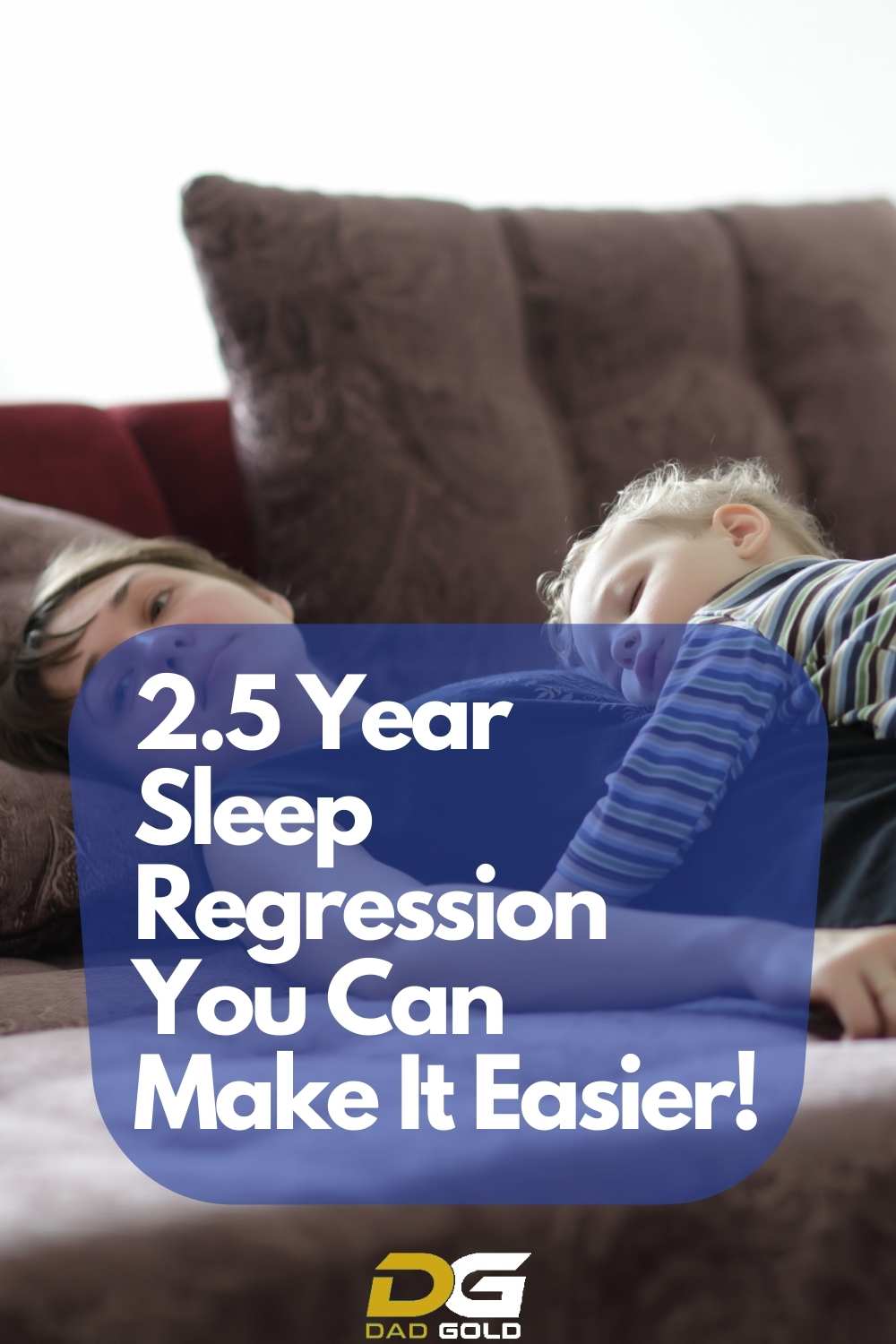You might be a first-time parent, and you are wondering why your child’s sleeping pattern has changed.
Or maybe you didn’t know that the term “sleep regression” existed!
You might have even heard about sleep regression, but you probably thought it ends at 18 months.
Well, I have some bad news for you… it happens even when your child is around 2 – 2.5 years old! Nobody said raising a toddler was going to be easy…
Sleep regression is a period when your baby or toddler who has been sleeping well suddenly begins to wake frequently at night or during naptime or completely refuses to go to sleep.
For most babies, sleep regressions may occur at 4 months, 8 to 10 months, 12 months, 18 months, and finally at 2 years. The most common sleep regression at 4 months; however, this article will focus on the sleep regression of a 2.5-year-old toddler, how long it lasts for, the signs, and how you can address the sleep regression.

Is There a 2.5-Year-Old Sleep Regression?
You might be asking, “Why is my 2.5-year-old waking up at night?” If your child around 2 years old is suddenly not sleeping as they used to, and you’ve noticed that they wake up at night frequently, get up too early, or do not take their daytime nap, your child is likely going through the 2-year-old sleep regression.
There are several reasons why your toddler might be experiencing changes in their sleep pattern. These include:
-

Bold Male Pride – Baseball Trucker Cap Celebrating Masculinity
£18.00 Select options This product has multiple variants. The options may be chosen on the product page -

Dad Bod Appreciation Gift Mug
£14.00 Add to cart -

Dad Bod, Bad Jokes Structured Baseball Cap
£22.00 Select options This product has multiple variants. The options may be chosen on the product page
- Separation anxiety – Fear and anxiety are some of the reasons why your child has a disrupted sleep pattern. Your 2-year-old might be afraid when left alone to sleep or with people that they don’t know. Some of them also feel that they will miss out on lots of fun if they are alone, so they don’t want to be left out.
- Transitioning to a new bed or potty training – Most kids at this age find it difficult to stay in bed, and they are seen to climb out of their crib. This can also prevent them from sleeping when they should. Also, toddlers who have transitioned from sleeping in a crib to sleeping on a bed tend to get out of bed more often because the bed is unfamiliar and there’s freedom. Also, if your little one is undergoing potty training, you might find them waking up from sleep to use the potty and find it difficult to go back to sleep.
- New sibling – Whenever a toddler notices that their baby sibling is getting all the attention, they have a sleep regression. They tend to feel that they now share everything, including you, with the baby, and so, they want to remain connected with you at all times, including at night time!
- Night-time fears – Around 2 years, your toddler might have fears at night due to their imaginations, and this can lead to nightmares. They might be afraid of the dark, shadows, or scary things that they have imagined. These fears make it difficult for them to fall asleep at bedtime. Some even wake up in the middle of the night, and you find them refusing to go back to sleep. They, therefore, want you to stay with them until they fall asleep. Night terrors are also common during the toddler years.
- Pain or discomfort – Many 2-year-olds are developing their second molars, which can be painful. Pain or discomfort from teething can disrupt your child’s sleep.
Apart from the reasons given above, it is easy to know your child is going through sleep regression based on when it happens and how long it lasts.
How Long Does The 2 Year Old Sleep Regression Last?
For most parents, sleep regression can be very frustrating and tiring; however, it is good to know that it is normal and won’t last forever.
Generally, sleep regressions usually last between two to six weeks (2 to 6 weeks). After this period, your toddler returns to their normal sleeping pattern. It is important to note that the length of the period varies from child to child. This period can also be shorter if you respond well to your child’s sleep disturbance.
Signs of The Dreaded 2.5 Year Sleep Regression (4 Signs)
If you notice any of the following signs in your child who has been sleeping very well, it is most likely a sleep regression.
- Nap resistance
- Bedtime resistance
- Frequent night waking
- Early morning wake-ups
- Wake up crying in the morning
1. Nap Resistance
Your toddler might not take a nap because they feel that they will miss out on all the good stuff that is going on outside their room if they do. So they decide to stay awake the whole time.
Nap resistance is easier to manage if your toddler still sleeps in a crib; however, if you put them in a bed, you might have to put things in place to prevent them from leaving the room during nap time. You can also encourage them to nap by creating a reward system.
2. Bedtime Resistance
Most two-year-old children are becoming aware of what they want, so they refuse to go to bed.
At this time, you can hear them saying random things or asking for one more story or one more song to assert their independence.
3. Frequent Night Waking
When your two-year-old has sleep regression, you notice that they frequently wake up at night.
This can be due to various reasons. It can be due to separation anxiety and wants to see you. It can also be due to night-time fears, or they might have discomfort from teething.
4. Early Morning Wake-Ups
If you notice that your child wakes up earlier than usual in the morning, then sleep regression is setting in. The wake-ups commonly seen during sleep regression are 5:00 to 5:30 am, compared to the normal 6:00 am to 7:00 am.
Also, if you are wondering, ‘why do toddlers cry when they wake up?’ then this sleep regression could be a reason.
Your Guide for Addressing the 2.5 Year Sleep Regression Phase
To navigate the sleep regression period properly, here are some steps you can take to help you and your toddler.
- Ensure that all the basic needs of your child are met. Also, make sure that they are safe and healthy and not in pain.
- Consider putting off transitioning to a new bed or toilet training till months later.
- Re-evaluate your child’s sleep schedule as necessary. Children around 2 years of age need to sleep for 11 to 14 hours per day. So you can split these number of hours between naptime and nighttime.
- Generally, two-year-olds take a 2-hour nap between 2:00 pm to 3:00 pm and go to bed at 7:00 pm to 8:00 pm; however, this can vary from household to household.
- Follow routines by ensuring that bedtime routine and nap time are consistent, no matter what. See this sample sleep schedule for 2-year-old kids; I am sure you will get some awesome ideas from it!
- Be calm and consistent in your response to your child’s behavior during the sleep regression period.
- For example, if your child keeps leaving their room, you should calmly take them back and put them in their bed.
- Understand your two-year-old’s fears and walk them through them. If your toddler has separation anxiety, giving them attention, especially before bedtime, can help them feel more secure.
Conclusion
Every child goes through a sleep regression, and it is completely normal. When your child is going through a sleep regression, the best thing to do is to ensure that you cope as much as you can. Also, ensure that you address any underlying issues that may contribute to sleep regression.
If you are patient and consistent, sleep regression will last for only a few weeks. Lastly, always remember that you are not alone, and there are many parents out there who are going through the same thing!
Good luck!


